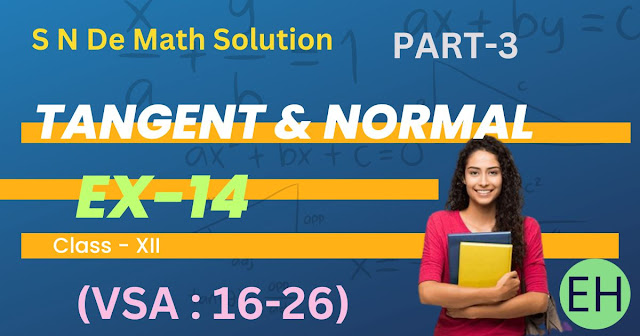 |
| Tangent and Normal | Part-3 |
In the previous article , we have solved few VSA type Questions. In the following article, we are going to discuss/solve few more Very Short Answer Type Questions of S.N.Dey Mathematics-Class 12 of the chapter Tangent and Normal (Ex-14).
Find the equation of the normal at the specified point to each of the following curves $~[16-26] :$
16. $~y^2=4ax~$ at $~(0,0,)$
Solution.
$~y^2=4ax \longrightarrow(1)$
Differentiating (1) w.r.t. $~x~$ we get,
$~2y~\frac{dy}{dx}=4a \Rightarrow ~\frac{dy}{dx}=\frac{4a}{2y}=\frac{2a}{y}. \\ \therefore~~ -\frac{dx}{dy}=-\frac{y}{2a} \\ \text{So,}~~ \left[-\frac{dx}{dy}\right]_{(0,0)}=0.$
Hence, the equation of normal to the parabola (1) at $~(0,0)~$ is
$~y-0=\left[-\frac{dx}{dy}\right]_{(0,0)}(x-0) \\ \text{or,}~~ y=0 \cdot x \Rightarrow y=0~~\text{(ans)}$
17. $~\frac{x^2}{a^2}+\frac{y^2}{b^2}=1~$ at $~(x,y).$
Solution.
$~\frac{x^2}{a^2}+\frac{y^2}{b^2}=1 \\ \text{or,}~~ b^2x^2+a^2y^2=a^2b^2 \longrightarrow(1)$
Differentiating (1) w.r.t. x, we get
$b^2 \cdot 2x+a^2 \cdot 2y~\frac{dy}{dx}=0 \\ \text{or,}~~ \frac{dy}{dx}=-\frac{b^2 \cdot 2x}{a^2 \cdot 2y}=-\frac{b^2x}{a^2y} \\ \therefore~~ \left[-\frac{dx}{dy}\right]_{(x,y)}=\frac{a^2y}{b^2x}.$
So, the equation of normal to the curve (1) at $~(x,y)~$ is
$~Y-y= \left[-\frac{dx}{dy}\right]_{(x,y)}(X-x) \\ \text{or,}~~ Y-y=\frac{a^2y}{b^2x}(X-x) \\ \text{or,}~~ a^2y(X-x)=b^2x(Y-y)~~\text{(ans)}$
19. $~\frac{x^2}{a^2}-\frac{y^2}{b^2}=1~$ at $~(a\sec\theta,b\tan\theta).$
Solution.
$~\frac{x^2}{a^2}-\frac{y^2}{b^2}=1 \\ \text{or,}~~ b^2x^2-a^2y^2=a^2b^2 \longrightarrow(1)$
Differentiating (1) w.r.t. $~x~$ we get,
$~b^2 \cdot 2x-a^2 \cdot 2y~\frac{dy}{dx}=0 \\ \text{or,}~~ \frac{dy}{dx}=\frac{b^2x}{a^2y} \\ \therefore~~ \left[-\frac{dx}{dy}\right]_{(a\sec\theta,b\tan\theta)}=\left[-\frac{a^2y}{b^2x}\right]_{(a\sec\theta,b\tan\theta)}\\~=-\frac{a^2 \cdot b\tan\theta}{b^2 \cdot a\sec\theta}=-\frac ab \sin\theta.$
So, the equation of normal to the curve (1) at $~(a\sec\theta,b\tan\theta)~$ is
$y-b\tan\theta=-\frac ab \sin\theta(x-a\sec\theta) \\ \text{or,}~~ by-b^2\tan\theta=-ax\sin\theta+a^2\sin\theta \cdot \frac{1}{\cos\theta} \\ \text{or,}~~ by-b^2\tan\theta=-ax\sin\theta+a^2\tan\theta \\ \text{or,}~~ ax \sin\theta+by=(a^2+b^2)\tan\theta \\ \therefore~~ ax\tan\theta+by \sec\theta=(a^2+b^2)\tan\theta\sec\theta~~\text{(ans)}$
Read More : Straight Line | Part-1 |Ex-2C
20. $~x^2+y^2-4x-6y+3=0~$ at $~(1,6).$
Solution.
$~x^2+y^2-4x-6y+3=0 \longrightarrow(1)$
Differentiating (1) w.r.t. $~x~$ , we get
$2x+2y~\frac{dy}{dx}-4 \cdot 1-6~\frac{dy}{dx}=0 \\ \text{or,}~~ (2x-4)+(2y-6)~\frac{dy}{dx}=0 \\ \text{or,}~~ \frac{dy}{dx}=-\frac{2(x-2)}{2(y-3)}=-\frac{x-2}{y-3} \\ \therefore~~ \left[-\frac{dx}{dy}\right]_{(1,6)}=\left[\frac{y-3}{x-2}\right]_{(1,6)}=\frac{6-3}{1-2}=-3.$
So, the equation of normal to the curve (1) at $~(1,6)~$ is
$y-6=\left[-\frac{dx}{dy}\right]_{(1,6)}(x-1) \\ \text{or,}~~ y-6=-3(x-1) \\ \text{or,}~~ y-6=-3x+3 \\ \therefore~~ 3x+y=9~~\text{(ans)}$
#1# Foundation Course Class 9 For 2023 Exam - Physics, Chemistry, Biology, Mathematics (Set of 4 Books) - NTSE-NVS-KVPY-BOARDS-IIT JEE-NEET-NSO Olympiad Exam Books
21. $~x^2+y^2=8~$ at point, where $~~\frac{dy}{dx}=-1.$
Solution.
$x^2+y^2=8 \longrightarrow(1)$
Differentiating (1) w.r.t. $~x~$ , we get
$2x+2y~\frac{dy}{dx}=0 \\ \text{or,}~~2\left(x+y~\frac{dy}{dx} \right)=0 \\ \text{or,}~~ \frac{dy}{dx}=-\frac xy$
By question,
$~ \frac{dy}{dx}=-1 \Rightarrow -\frac xy=-1 \Rightarrow x=y=h~(\text{say})$
$\therefore~~ \left[-\frac{dx}{dy}\right]_{(h,h)}=1$
So, the equation of normal to the curve (1) at $~(h,h)~$ is given by
$y-h=1 \cdot (x-h) \Rightarrow y-h=x-h\\~~ \Rightarrow x-y=0~~\text{(ans)} $
22. $x^3+y^3=3axy~$ at $~\left(\frac{3a}{2},\frac{3a}{2}\right)$
Solution.
$x^3+y^3=3axy \longrightarrow(1)$
Differentiating (1) w.r.t. $~x~$ , we get
$3x^2+3y^2~\frac{dy}{dx}=3a \left(1 \cdot y+ x \cdot \frac{dy}{dx}\right) \\ \text{or,}~~ x^2+y^2~\frac{dy}{dx}=ay+ax~\frac{dy}{dx} \\ \text{or,}~~ (y^2-ax)~\frac{dy}{dx}=ay-x^2 \\ \therefore~~ \frac{dy}{dx}=\frac{ay-x^2}{y^2-ax}.$
$\text{So,}~~ -\frac{dx}{dy}=-\frac{y^2-ax}{ay-x^2}=\frac{ax-y^2}{ay-x^2} \\ \therefore~~ \left[-\frac{dx}{dy}\right]_{(3a/2 ,3a/2)}=\frac{a \cdot \frac{3a}{2}-(3a/2)^2}{a \cdot \frac{3a}{2}-(3a/2)^2}=1$
So, the equation of normal to the curve (1) at the point $~\left(\frac{3a}{2},\frac{3a}{2}\right)~$ is
$y-\frac{3a}{2}=1 \cdot \left(x-\frac{3a}{2}\right) \\ \text{or,}~~ y=x \Rightarrow x-y=0~~\text{(ans)}$
23. $~x=y^2-4y~$ at points, where the curve crosses the y-axis.
Solution.
$x=y^2-4y \longrightarrow(1)$
Let the curve (1) crosses the y-axis at $~(0,k).$
$\therefore~~ 0=k^2-4k \Rightarrow k(k-4)=0 \\ \therefore~~ k=0,4.$
So, the required points are $~(0,0),~(0,4).$
Now, differentiating (1) w.r.t. $~x~$, we get
$1=2y~\frac{dy}{dx}-4~\frac{dy}{dx} \\ \text{or,}~~ (2y-4)~\frac{dy}{dx}=1 \Rightarrow \frac{dy}{dx}= \frac{1}{2y-4}. \\ \therefore~~ -\frac{dx}{dy}=-(2y-4)=4-2y \\ \text{So,}~~\left[-\frac{dx}{dy}\right]_{(0,0)}=4-2\times 0=4.$
The equation of normal to the curve (1) at $~(0,4)~$ is
$y-0=4(x-0) \Rightarrow 4x-y=0~~\text{(ans)}$
Again, $~~\left[-\frac{dx}{dy}\right]_{(0,4)}=4-2 \times 4=-4$
The equation of normal to the curve (1) at $~(0,4)~$ is
$y-4 =-4(x-0) \Rightarrow 4x+y=4~~\text{(ans)}$
24. $~x=at^2,~y=2at~$ at the point $~t.$
Solution.
$x=at^2 \Rightarrow \frac{dx}{dt}=a \frac{d}{dt}(t^2)=a \cdot (2t)=2at,\\~~y=2at \Rightarrow \frac{dy}{dt}=2a ~\frac{d}{dt}(t)=2a \cdot 1=2a.\\ \therefore~ \frac{dy}{dx}=\frac{dy/dt}{dx/dt}=\frac{2a}{2at}=\frac 1t \\ \text{So,}~~ -\frac{dx}{dy}=-t.$
Hence, the equation of normal to the given curve at the point $~t~$ is
$~y-2at=-t(x-at^2) \\ \text{or,}~~ y-2at=-tx+at^3 \\ \text{or,}~~ y+tx=2at+at^3~~\text{(ans)}$
25. $~x=a(2\cos t+\cos2t),~y=a(2\sin t-\sin2t)~$ at $~t=\frac{\pi}{2}.$
Solution.
$x=a(2\cos t+\cos 2t) \\ \therefore~~ \frac{dx}{dt}=a \cdot \frac{d}{dt}(2 \cos t+\cos 2t)\\ \text{or,}~~ \frac{dx}{dt}= a(-\sin t-2\sin 2t)\\ \text{or,}~~ \frac{dx}{dt}=-2a(\sin t+\sin 2t ) $
$y=a(2\sin t-\sin 2t)\\ \therefore~~ \frac{dy}{dt}=a \frac{d}{dt}(2\sin t-\sin 2t) \\ \text{or,}~~\frac{dy}{dt}= a(2\cos t-2\cos 2t) \\ \text{or,}~~ \frac{dy}{dt}= 2a(\cos t-\cos 2t) \\ \therefore~~ \frac{dy}{dx}=\frac{dy/dt}{dx/dt}=\frac{2a(\cos t-\cos 2t)}{-2a(\sin t+\sin 2t)}=\frac{\cos 2t-\cos t}{\sin t+\sin 2t} \\ \text{So,}~~ -\frac{dx}{dy}= \frac{\sin t+\sin 2t}{\cos t-\cos 2t} \\ \therefore~~ \left[-\frac{dx}{dy}\right]_{t=\pi/2}=\frac{\sin(\pi/2)+\sin \pi}{\cos(\pi/2)-\cos \pi}=1$
$[x]_{t=\pi/2}=a\left(2\cos \frac{\pi}{2}+\cos \pi\right)=-a,\\~~ [y]_{t=\pi/2}=a\left(2\sin \frac{\pi}{2}-\sin \pi\right)=2a.$
Hence, the equation of normal to the given curve at $~t=\pi/2~$ is
$y-2a=1 \cdot (x+a) \\ \text{or,}~~ y-2a=x+a \\ \therefore~~x-y+3a=0.$
26. $~x=a\sin^3t,~y=b\cos^3t~$ at the point $~t.$
Solution.
$x=a\sin^3t \Rightarrow \frac{dx}{dt}=3a \sin^2 \cos t,\\~ y=b\cos^3t \Rightarrow \frac{dy}{dt}=-3b\cos^2t \sin t \\ \therefore~~ \frac{dy}{dx}=\frac{dy/dt}{dx/dt}=\frac{-3b\cos^2t \sin t}{3a \sin^2t \cos t} \\ \text{or,}~~ \frac{dy}{dx}=-\frac ba \cot t \Rightarrow -\frac{dx}{dy}=\frac ab \tan t.$
Hence, the equation of normal to the given curve at the point $~t~$ is
$y-b \cos^3t= \frac ab \tan t(x-a \sin^3t) \\ \text{or,}~~ by-b^2 \cos^3t=ax \tan t-a^2\tan t \sin^3t \\ \text{or,}~~ -ax \tan t +by=b^2\cos^3t-a^2 \tan t \sin^3t \\ \text{or,}~~ ax \tan t -by=-b^2\cos^3t\\~~~+a^2 \tan t \sin^3t \\ \text{or,}~~ \cos t \left[ax~\frac{\sin t}{\cos t}-by\right]\\~~=\cos t \left[a^2 \frac{\sin t}{\cos t}~\sin^3t-b^2 \cos^3t\right] \\ \text{or,}~~ ax \sin t-by \cos t=a^2\sin^4t-b^2 \cos^4t~~\text{(ans)} $










Please do not enter any spam link in the comment box